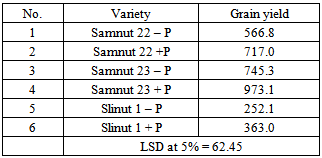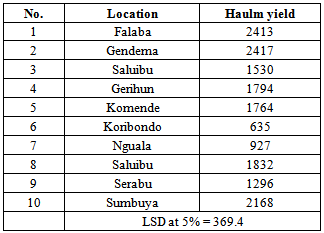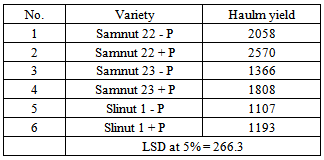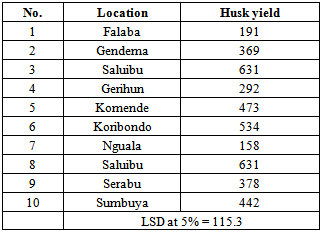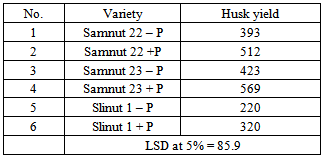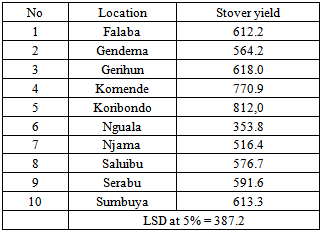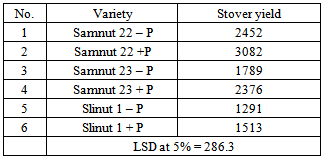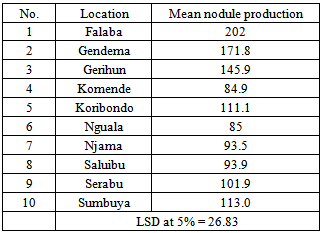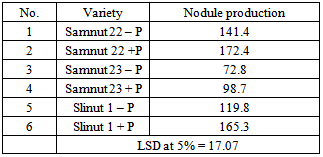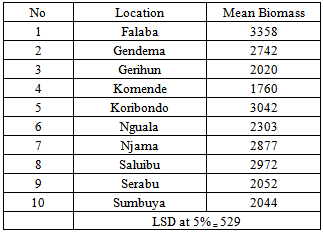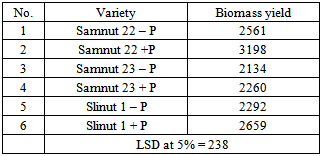-
Paper Information
- Next Paper
- Previous Paper
- Paper Submission
-
Journal Information
- About This Journal
- Editorial Board
- Current Issue
- Archive
- Author Guidelines
- Contact Us
International Journal of Agriculture and Forestry
p-ISSN: 2165-882X e-ISSN: 2165-8846
2014; 4(2): 106-111
doi:10.5923/j.ijaf.20140402.10
Response of Groundnut (Arachis hypogaea L) Varieties to Phosphorous in Three Agro Ecologies in Sierra Leone
Abdul-Rahman Tarawali
Sierra Leone Agricultural Research Institute, Njala, Sierra Leone
Correspondence to: Abdul-Rahman Tarawali, Sierra Leone Agricultural Research Institute, Njala, Sierra Leone.
| Email: |  |
Copyright © 2014 Scientific & Academic Publishing. All Rights Reserved.
Ten Groundnut trials were conducted in June 2012 and June 2013. The objectives of the trials were to evaluate the performance of two (2) improved /Exotic Groundnut varieties (Samnut 22 and Samnut 23) and one improved local variety (Slinut 1) and their responses to phosphorous (P) fertilizer in three Agro ecological zones–Rain forest, transitional rain forest and Savannah woodland, in the Eastern and southern province of Sierra Leone. The experiments were laid out in a randomized complete block design with three replications. The variety Samnut 23 performed significantly higher in terms of grain yield than the varieties Samnut 22 and Slinut 1 at all location in both years. Addition of Single Super phosphate (SSP) fertilizer enhanced the performance of all the varieties and increased the formation of nodules by the varieties and had significant effect on Biomass production. Samnut 22 produced significantly more stover yield than Samnut 23 and Slinut 1. Slinut 1 is an early maturing variety; Samnut 23 is a medium maturing variety while Samnut 22 is a late maturing variety. Samnut 23 is recommended for dissemination to farmers for seed production, while Samnut 22 is recommended for dissemination to farmers who are interested in both seed and fodder production.
Keywords: Samnut, Arachis hypogaea, Agro-ecologies, Haulm, Stover, Biomass, Fodder
Cite this paper: Abdul-Rahman Tarawali, Response of Groundnut (Arachis hypogaea L) Varieties to Phosphorous in Three Agro Ecologies in Sierra Leone, International Journal of Agriculture and Forestry, Vol. 4 No. 2, 2014, pp. 106-111. doi: 10.5923/j.ijaf.20140402.10.
Article Outline
1. Introduction
- Groundnut (Arachis hypogaea L.), also known as peanut, is an important food and cash crop across West Africa. The crop is cultivated mainly by small-household and resource-poor farmers. Cultivated groundnut (Arachis hypogaea L.) belongs to genus Arachis in subtribe Stylosanthinae of tribe Aeschynomenea of family Leguminosae (Ntare et al. (2008)). It is a legume that ranks 4th among the oilseed crops and 13th among the food crops of the world. It provides high quality edible oil (48–50%), easily digestible protein (26–28%), and about half of the 13 essential vitamins and more than a third of the 20 essential minerals necessary for human growth and maintenance. In addition it produces high quality fodder for livestock. (Taru et al., 2008; Multipurpose Groundnut Feb 2009).Groundnut is by far the most important grain legume grown in Sierra Leone (IDRC, 1982.). Planting is done at the onset of the rains, between April and June and harvesting is done in August and September. Production in Sierra Leone is completely by hand using hoes and no input of fertilizer or pesticides using predominantly disease susceptible local varieties.According to FAO STAT (2008) yields of Groundnut in Africa are much lower than the average world yields, and yields in Sierra Leone are very low (0.6-0.7 tons/ha.). Researchers attribute low yield to biotic, abiotic and socio-economic factors (Pande et al 2003) including soil nutrient deficiencies (especially Calcium) moisture stress, pest (especially Rodents) and disease problems, low plant population, Poor weed control and unavailability and lack of access to quality seed of improved varieties. The importance of phosphorous for legume production has been recognized for a long time. Franco et al. (1976) have suggested that legumes may require more phosphorous than non-legume because of their higher requirement of phosphorous for symbiotic nitrogen fixation. Anil Kumar Das et al (2008) state that among the essential plant nutrients phosphorous is most important for seed production, helping to form a healthy and sound root system which is essential for nutrient uptake. Phosphorous plays a role in cell division, flowering, crop maturation, root development and nodulation. Phosphorus plays an important role in the maturity of the crop, root development, photosynthesis, nitrogen fixation and other vital physiological processes. In the order of importance to crop performance, phosphorus is rated second to nitrogen (Gervey R., 1987). Balasubramanian et al. (1980) b. observed that phosphorus application results in better nodulation and seed yield. Rhodes E. (1983) reported that phosphorus application improved nodulation and seed yield of cowpea. El-Dsouky et al. (1999) also attributed increased number and weight of nodules, nitrogen activity and groundnut yield to phosphorus fertilization. Kwari (2005) reported that, low phosphorus content of the soil may restrict rhizobia population and legume root development, which in turn can affect their N2 fixing potential. Studies conducted in Savanna regions of Nigeria showed that application of P at the rate 20-40 kg ha-1 significantly improved the performances of the grain legumes, groundnut (Balasubramanian et al. 1980) a.The N2 Africa project introduced the present work through a grant through IITA from Wageningen University (Prime Sponsor) to assess performance of two varieties of Groundnut in different locations and different agro-ecologies in Sierra Leone. Specifically these experiments considered two (2) improved /Exotic Groundnut varieties (Samnut 22 and Samnut 23) for evaluation of their performances and their responses to phosphorous (P) fertilizer in different agro ecologies in Sierra Leone.
2. Material and Methods
- The experimental set up was a randomized block design, with groundnut variety and P rate arranged in a factorial combination, replicated three times.Phosphorus was applied as single superphosphate (SSP) with 18% P2O5, at 0 (Control) and 225 kg ha-1 SSP per ha.Three varieties were used in these trials; Samnut 22, Samnut 23 and Slinut 1 (local control released by SLARI).Planting was done in six randomized plots, making one block in a randomized complete block design with three replications. Each plot consisted of Six rows with twenty plants per row. The intra row distance was 20 cm. and the inter row distance was 50cm. No P was added to the – P plots and 270g SSP was added to the +P plots by banding at planting. One seed of groundnut was planted per hill for all the varieties. Each of the trials was weeded three times before harvest.
2.1. Data Collection and Data Analysis
- Data was collected on % germination, Above ground biomass in subsample area of 2m2, Oven dry weight of biomass subsample, Mean nodule per treatment (sub sample of 10 plants per plot), Total fresh weight of all pods in central 2m x 2m plot, Total fresh weight of all haulms in 2m x 2m plot, oven dry weight of subsample of haulms, 100 seed weight, Grain yield, and Stover (haulm+husk/empty pods yield).Data analysis was with Genstat discovery edition 3. The combined analysis was analysed as a split – split plot design with years as the Whole/main plot factor, Locations as the sub plot factor and treatment combinations as the sub-sub plot factors. The means were separated using Least Significant Difference (LSD), according to Gomez and Gomez (1984).
2.2. Experimental Sites
- The experiment in both years were conducted at different sites within the same vicinity to eliminate any residual effect of fertilizer application and as a precautionary disease control mechanism. The Agro ecologies targeted in the study were the Rain forest in the Eastern province, Transitional Rain forest and the Savannah woodland in the Southern province of Sierra Leone.
3. Results and Discussions
3.1. Seed Yield
- The mean seed yields (averaged over 10 locations) of the crop in 2012 was significantly higher than the mean seed yield in 2013 at the 5% level of probability. This is probably due to the difference in Rainfall pattern in both years. Although significantly more rain fell in 2013 than in 2012. The rainfall in 2013 was heavy in the early stages of growth of the crop in most of the locations resulting in poor establishment of the crops. The year x location effects were also highly significant depicting differences in rainfall within the years in the different locations.The Seed yield of the different varieties including their interaction effect with location and years and the treatment combinations were significantly different at the 5% level of probability. The variety Samnut 23 had the highest mean seed yield in both 2012 and 2013 in all locations followed by Samnut 22. There is a consideration (Bala H.M.B. et al 2011) that variety Samnut-23 is inherently higher-yielding than Samnut-22 which implies that the variety is better efficient in the manufacture of assimilate and partitioning of same to the reproductive sink. This may explain the superiority in seed yield production of Samnut 23 over variety SamnutT-22. The superior performance of Samnut 23 over Samnut 22 in all location tried within two years is also reported by Kamara A.Y. et al. 2011. Who worked in two locations within two years (2005 and 2006) in the tropical savannas in northeast Nigeria.Phosphorous treated plots produced significantly higher seed yield than plots without phosphorous (Table 1) in all locations and treatment combinations. This confirms a report by Tran Thi Thu Ha (2003) He reports that Phosphorus fertilizer significantly increased groundnut yield in both poor alluvial and sandy soils and that the most appropriate P application rate for groundnut is 60 kg P2O5/ha for poor alluvial soil and 90 kg P2O5/ha for sandy soil. Tran Thi Thu Ha also observed that agronomic efficiency for P showed a similar trend and was maximized at 60 and 90 kg P2O5/ha, in the poor alluvial and sandy soils, respectively. Kumar Das (2008) observed an increase in seed yield of chickpea with incremental doses of phosphorous up to 60 kg P2O5 ha-1. Rajkishore Ranjit 2005 reports that the number of filled pods per plant, total number of pods per plant at harvest and pod yield per hectare and consequently yield in groundnut were influenced by different levels of phosphorus application.
|
3.2. Haulm Yield
- Significantly more haulm was produced by the crop in 2012 = 2297 Kg/ha than the crop in 2013 = 1059 Kg/ha. (p =.001, LSD5%=185.8). The location, effect and their various interactions with year and treatment combinations were very significant (Table 2). This may indicate the relevance of variety and the environment (rainfall pattern and soil/location) in Haulm production. The variety Samnut 22 produced more haulm than the varieties Samnut 23 and the local check Slinut 1. Kamara, A.Y. et al 2011 in confirmation reports the shorter duration to maturity Samnut 23, produced less fodder and Haulm yield than the longer duration to maturity Samnut 22. All the varieties showed increased haulm yield (increased dry matter production) with the application of Phosphorous (Table 3). Anil Kumar Das et al. (2008), Ranjit, 2005, Kamara E.G,. et al 2011 and Kausale S.P. et al 2007 also reported increased haulm production with addition of Phosphorous Singh and Ahuja 1985 reported that applied phosphorous increased the leaf area and increased accumulation of dry matter.
|
|
3.3. Husk Yield
- The husk produced by the varieties was significantly affected by the variety, location and their interactions at the 5% level of probability. Husk production was dependent on pod produced by the treatment combinations at the different locations. The varieties produced significantly more husk in 2012 than in 2013 (p <.004) this may be due to the superior performance of the crop in 2012 than in 2013. Saluibu produced more husk than the other locations Table 4 shows the husk production by locations.
|
|
3.4. Stover Yield
- Year had a significant effect on stover production by the different treatment combinations, with more stover being produced in 2012 than in 2013 (p = .002). This difference is due to the superior performance of the crop in 2012 due to more even rainfall distribution.The Stover production by the treatment combinations was significantly affected by location (p <.001) (Table 6).
|
|
3.5. Nodule Formation
- The treatment combinations and locations and their interaction had significant effect on the mean number of nodules produced by the varieties. The variety Samnut 22 produced the most nodules followed by Slinut 1 and then Samnut 23. This is in line with the findings of Fohse et al. (1998) and Paul and Giller (2002) who observed species and varietal differences in the ability of legumes to extract soil P. This may depend upon the potential of roots to absorb P, in their active life time, the amount of root per unit of shoot, and the nature of organic acid exude by roots. Nodule production of the varieties was not significantly different in both years probably indicating that nodule production was genetically controlled. Varietal response for nodule production to phosphorous addition is shown in (Table 8).There was a significant effect of the addition of phosphorous on nodule production (Table 9). Addition of phosphorous increased nodule production as reported also by Kausale S.P. et al 2007, Yakubu H et al 2010 and Anil Kumar Das et al (2008). High response of the varieties to phosphorous with respect to nodule formation may be due to low native phosphorous content in Sierra Leonean soils in addition to the role of phosphorous in groundnut production – root formation, nodule initiation, nodule growth and functioning in nitrogen fixation.
|
|
3.6. Biomass Production
- The above ground Biomass produced was significantly affected by the year, location and by the varieties and their various interactions. Table 10 shows Biomass production of the treatment combinations at the various locations.
|
|
4. Conclusions
- This study found that the response of groundnut to phosphorous (P) application was consistent over all locations in the three Agro ecological regions, which validate and reinforces the importance of P for production of groundnut in Sierra Leone. It was also found that the effect of phosphorous was influenced by the variety with some varieties showing higher response either in terms of grain yield, Haulm production, and Nodulation or Biomass production than the others. The variety ‘Samnut 23’ which is early to medium maturing produced higher seed yields than the other varieties Samnut 22 and Slinut 1. The late maturing Samnut 22, however, produced higher fodder yields than ‘Samnut 23’. Both these varieties (Samnut 23 and Samnut 22) are less susceptible to the prevalent Cercospora leaf spot disease. The variety ‘Samnut 23’ which is of a similar duration to maturity as most of the local varieties but is higher yielding and relatively disease resistant is recommended for farmers in Sierra Leone. However, for farmers interested in fodder for their livestock in addition to grain, the variety Samnut 22’ is recommended. Both Samnut 23 and Samnut 22 outperform the local variety.
ACKNOWLEDGEMENTS
- We thank the Howard Buffet foundation for funding the N2 Africa Groundnut variety and input use trials. We also thank the Scientists from IITA and Wageningen University for their management and supervisory visits to the trial sites/fields in Sierra Leone.
 Abstract
Abstract Reference
Reference Full-Text PDF
Full-Text PDF Full-text HTML
Full-text HTML